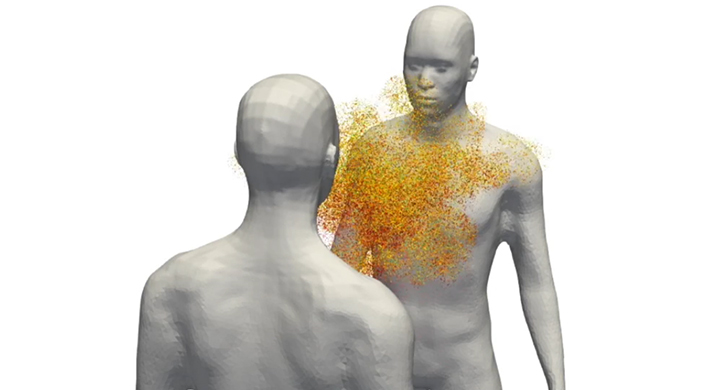Turbulence is a natural aspect of complex flows such as those surrounding eoliens or water flow in a hydraulic turbine. And of course, they are also part of the air we breath!
The air we breathe is one suspected means of spreading Covid-19. What happens when your neighbor sneezes or simply breathes near you? Micro-droplets containing the virus can be expelled and float through the air, making it possible for someone to breath them in. To better understand this phenomenon, LEGI researchers were contacted by colleagues at TIMC (CNRS, CHU Grenoble Alpes, Grenoble INP, UGA, VetAgro Sup) in order to: “Evaluate the risks presented by this form of transmission and the efficiency of preventive measures used in a variety of contexts. Digital simulation offers an efficient means to evaluate the situation as long as we are able to reliably reproduce the physics of the phenomenon,” explains Guillaume Balarac, lecturer at Grenoble INP - Ense³ and a LEGI researcher.
Particles and turbulence
With their strong expertise on fluid mechanics, and in particular turbulence, the researchers analyzed the impact of turbulence on particles floating in the air. With the current crisis, their research work was carried out in collaboration with colleagues from CORIA, IMAG, Vermont University and SAFRAN Group, and their analysis was able to benefit from 10 million hours of calculations on the Joliot-Curie supercomputer located at CEA Paris-Saclay!
A fluid’s behavior is governed by the Navier-Stokes equation, which intrinsically includes turbulence. Turbulence is a phenomenon that is active throughout a wide range of spatial scales. To reduce calculation times, smaller scale turbulence is described using a simple, universal model. Large-scale turbulence is simulated through calculations, while smaller ones are modelized. This approach, known as large-scale simulation, greatly reduces calculation time while ensuring sufficient accuracy.
The researchers used this method, which is integrated in the YALES 2 calculation code, to study the path of droplets according to their size, external air flow (ventilation), etc. “The results, which are still being collected and analyzed, could help evaluate the efficiency of protection equipment such as visors.” However, for the result to be useful, they will also need to be analyzed by experts in biology and virology in order to extract concret, applicable conclusions.
